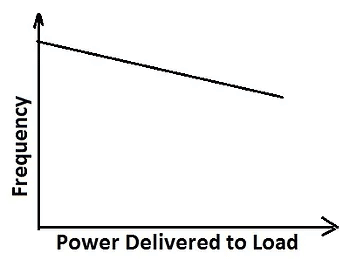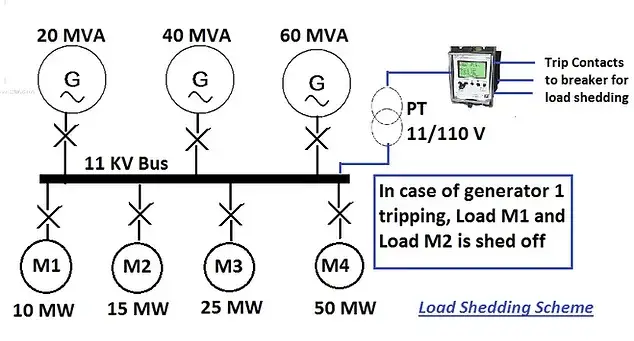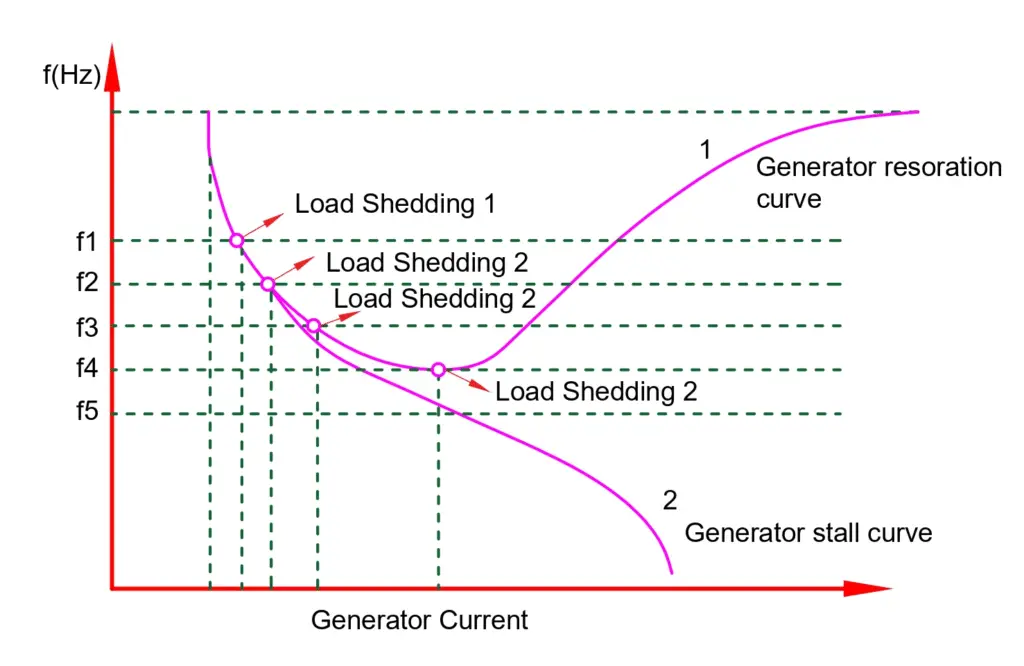df/dt Relay – Rate of Change of Frequency(ROCOF) Relay is used for load shedding when there is a sudden loss of generating capacity. In this condition, the supply frequency decreases, and the df/dt relay protects the power system by load shedding.
Why Frequency should be within the permissible limits?
First, let us understand what is frequency and on what factors supply frequency depends. The voltage and frequency both are governed by the generator at the generating station. The frequency denotes the active power and the voltage is reactive power for a generator. The drop in the rotational speed of the turbine decreases the frequency and the increase in the rotational speed of the turbine increases the frequency. The graphical representation of the frequency and load of a generating station is shown below.

When the load on the generator increases the turbine governor valve opens and supplies more steam to the turbine. When the load decreases the valve closes and cuts off the steam. Thus the frequency of the supply system is governed by controlling the main steam valve. What happens if the valve is fully open and still the frequency is at low, it means the load on the generator is more than it can supply. The lower frequency situation may further stall the turbine.
From above, it is very clear that the operation of the generating station gets affected by changes in the frequency either change in frequency from the load side or due to problems in generating station. To prevent the generating station stoppage on account of frequency variations, certain protection devices like over frequency, under frequency, and rate of change of frequency(ROCOF) relay are used to shed the load to bring the supply frequency within the rated frequency range.
The large generator has a large machine constant and the generator is capable to maintain the frequency within range. A large disturbance in the power network may cause the grid frequency to change by 1 Hz, whereas the small generating station has a lower machine constant and may cause a lower frequency for the same perturbation. Therefore, the small capacity generating stations are more vulnerable to frequency dips than large rating generators because small capacity generators are less resilient than large ones.
How df/dt Relay Can Prevent total Power Outage?
Let us understand the low-frequency phenomenon with an example. Let three generators of 20 MVA,40 MVA, and 60 MVA run in parallel supplying a total load of 100 MW. Suppose a 20 MW generator trips due to some fault, the other healthy generators may not be capable of delivering the load and the frequency will drop down. In this condition, if a load of a certain part is not cut off the other generators will also trip one by one, and this leads to a blackout.

The frequency relay measures and monitors the supply frequency. There are three elements in the frequency relay- Over frequency element(81H), Under frequency element(81L), and rate of change of frequency element(81R). The frequency relay monitors the rate of change of frequency( df/dt) and if the rate of change of frequency is higher than the threshold limit of df/dt, the relay outputs a tripping command to the breaker to shed the part of the load to bring the load less than the rated capacity of the generators in service.

If the relay further observes that the frequency has fallen below the threshold limit of the lower frequency range then again a relay trips the breaker to cut off more load from the bus. Thus, the frequency relay sheds off the part load of the bus by tripping the breaker to save the generator and ensure the availability of the supply.
Operating principle and Setting of df/dt Relay:
The frequency relay measures the frequency at many points of the AC waveform in one cycle. The rate of change of the frequency is calculated by the internal circuitry of the relay. The df/dt relay measures two successive frequencies and the time difference between two successive frequencies. The relay measures the df/dt for three consecutive wave cycles and an average value of this is the final measurement of df/dt. The measurement accuracy of df/dt depends on the accuracy of frequency measurement. The frequency is measured by measuring the time between two zero crossings.
Let the frequency is f1 at time t1 and frequency f2 at time t2. Then the rate of change of frequency is;

The minimum relay setting of 0.1 Hz/Sec can be done. The setting of the rate of change of frequency is generally kept at 0.3 Hz/Sec. to 0.4 Hz/sec.
ANSI code of rate of change of frequency relay- ROCOF Relay is ANSI 81R.
This is all about df/dt Relay – Rate of Change of Frequency(ROCOF) Relay.